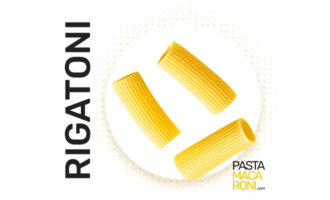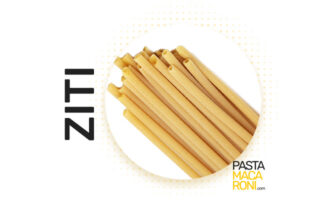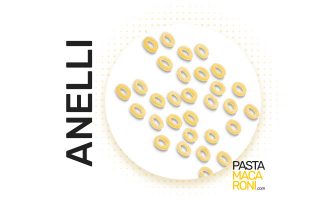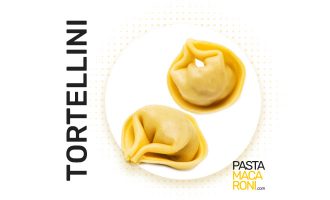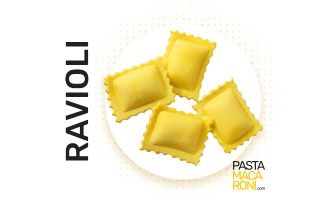Shape – a long thick pasta with a hole, 2.8 – 3 mm in diameter.
Cooking time – 12-14 minutes (until ready).
Bucatini combines with vegetable dressings and meat tomato sauces.
Briefly about Bucatini pasta
Bucatini pasta is a type of Italian pasta made from wheat flour and water that is usually served hot with rich creamy sauces or lighter sauces such as tomato or pesto. They are usually cooked in boiling salted water for 10-14 minutes, and a 2 oz. serving contains about 200 calories, 40 grams of carbs, 7 grams of protein.
You have come to make delicious bucatini?
What does bucatini look like 📏 Pasta shape

Bucatini pasta is a type of long, thick pasta with a hollow center, resembling the shape of a tube or a long thin cylinder. They are 8-10mm thick, with a hole diameter of 3-4mm. The length is usually about 250-260 mm, like standard spaghetti.
What is bucatini – Description of the species
Bucatini pasta is a type of Italian pasta that is made from wheat flour and water. It is a long, thick pasta that resembles a tube or thin cylinder with a hollow center. The name “bucatini” comes from the Italian word “bucato,” which means “hole,” that is, the hollow center of the pasta. Translated, “bucato” means pierced or perforated.
Bucatini, also known as perchatelli (Italian: Perchatelli), first appeared in Naples and belonged to a group of elongated dry pasta. It resembles thick spaghetti, but has a hollow core.
Bucatini is often served throughout the province of Lazio and is especially popular in Rome.

What does bucatini go with
Bucatini pasta is an Italian classic, and it’s easy to see why. Its long, hollow shape is the perfect vessel for a variety of delicious sauces. Bucatini can be used to make a variety of delicious dishes, from the classic tomato Amatriciana, a simple cacio e pepe, to the creamy and cheesy Carbonara sauce – .
The most appropriate sauce for bucatini is considered amatriciana sauce with loin and tomato. Bucatini can also be combined with lighter sauces, such as a simple tomato sauce or pesto sauce. Vegetable dressings of tomato sauce with sweet peppers, eggplant, zucchini, olives and a little capers also go well with this type of pasta.
Also, bucatini can be used in vegetarian dishes for a light and flavorful meal. This pasta pairs well with fresh herbs, tomatoes and cheese. For a gluten-free option, try making bucatini with chickpea flour or quinoa flour.
But if you’re looking for something more unique, why not try some unique bucatini sauces? From spicy arrabiata to rich nutty pesto, you can make some really unique bucatini dishes that will have your family and friends begging for more. So if you’re looking for something new and interesting, why not experiment with bucatini and some of these delicious sauces? You won’t be disappointed!
Substitute for bucatini pasta
If you don’t have bucatini pasta on hand, there are several other types of long pasta that can be substituted in the recipe. Bavette, Maccheroncini, Spaghettoni, Fettuccine or Bavette are good options. All of these types of pasta are similar in shape and size to bucatini, so they should work well in most recipes.
Serving and combining with bucatini pasta
Bucatini pasta is usually served hot and is often paired with rich, creamy sauces or hearty meat sauces. Popular sauces for bucatini include carbonara, cacio e pepe and amatriciana. The long, hollow shape of the pasta is perfect for holding these sauces together, making each bite full of flavor. Bucatini can also be served with lighter sauces, such as a simple tomato sauce or pesto sauce.
In Italian cuisine, this pasta is often served with meat, vegetables, cheese, eggs, and anchovies.
Depending on the type of dish you’re cooking, you can choose traditional bucatini made with durum wheat flour or different alternatives, such as gluten-free or whole-grain bucatini. Whether you want to create a classic Italian pasta dish or something more creative, you’ll always find a bucatini option that works for you!

🗒️ Calories and Nutritional Value
- Energy value 1492 kJ / 351 kcal
- 1 g fats
- Carbohydrates 70 g
- Protein 14 g
Nutritional Factors (average per 100g) – Bucatini n°12 La Molisana.
Made from durum wheat flour, bucatini is a great source of fiber, protein and carbs. A 2-ounce serving of bucatini pasta contains about 200 calories, 40 grams of carbs, 8 grams of protein and 1 gram of fat. It is also a good source of several essential nutrients, including B vitamins and iron.
⏲️ Cooking time | How long to cook Bucatini
- Until ready – 12-14 minutes
- Al dente – 9-11 minutes
The cooking time for bucatini pasta depends on the size of the pasta and the desired degree of doneness. Generally, bucatini should be cooked in a large pot of boiling salted water for 10-14 minutes, or until they become al dente (firm to the taste, but not mushy). While cooking, it is important to taste the pasta often to make sure it is cooked to your liking.
🧑🍳 Best recipes with Bucatini – 5 Easy and delicious pasta
Do you love pasta but are tired of the same old dishes? If so, bucatini pasta is the perfect way to diversify your dinner table. These thick, spaghetti-like noodles are as delicious as they are unique, and their hollow center is perfect for holding sauces and other toppings.
Bucatini Carbonara – Creamy pasta recipe without cream and milk
Ingredients for 4-6 servings:
- ¼ pound guanciale (pork cheek) or pancetta, cut into cubes
- 7 large egg yolks
- 1 large egg
- 1 pound bucatini or rigatoni
- Salt
- ½ cup finely grated pecorino or parmesan, plus more for garnish
- 2 teaspoons freshly ground black pepper
This recipe gets creamier with more yolks – no cream. It’s unlike any creamy carbonara you’ve tried. The sauce is bright yellow from the fresh eggs, and each boucatini portion hides cubes of fatty guanchiale. The tricks? Discarding most of the egg whites: their water liquefies the sauce. This is a pasta worth mastering.
Bucatini all’Amatriciana – Simple classic recipe
Ingredients:
- 1 lb. – Bucatini.
- 28 oz – Peeled whole tomatoes in a can
- 7 oz. Guanchiale, pancetta or bacon
- 1 tbsp – hot pepper flakes
- 1/2 cup – white wine, I use Chardonnay
- Pecorino cheese, grated for the filling
- Extra virgin olive oil
- Basil leaves (optional)
It’s very easy to make, and it’s perfect for those busy weekdays or weeknight when you don’t have a lot of time and don’t want to stand at the stove.
When it comes to easy bucatini dinners, it’s hard to beat the classic Bucatini all’Amatriciana dish. This traditional Italian dish is made with bucatini pasta, tomato sauce, pork cheeks and pecorino romano sheep cheese. It’s a delicious and hearty dish that can be served in just 30 minutes or less.
For a lighter, healthier dinner, try this vegetarian recipe for bucatini with roasted vegetables and creamy white beans. It’s full of flavor, yet light enough to be enjoyed any day of the week. Looking for something gluten-free? There’s a variation to try this bucatini recipe with roasted cauliflower and toasted almonds. It’s certainly not the original Amatriciana options, but these ingredients might appeal to those who don’t eat meat.
Bucatini Alfredo — Creamy Pasta Recipe
Ingredients:
- Whipping cream
- Bucatini pasta
- Parmesan cheese
- Italian parsley
- Garlic
- Shallot
- Lemon
- Truffle oil
- Sun-dried tomatoes
- Red chili flakes
- Pinch onion powder
- Lean bacon
- Frozen peas
- Salt
- Pepper
- Dry vermouth
- Olive oil
The best bucatini alfredo creamy pasta with truffle, bacon and vegetables according to the MoreSeasoning channel. It’s a delicious and simple dish, and you can experiment with it all you want! Feel free to swap out or remove the veggies, buttery or truffle oil!
Tuna pasta with garlic and chili – Delicious Bucatini recipe in 15 min
Ingredients:
- 6 oz – 170 g bucatini or spaghetti
- 6.5 oz – 185 g can of tuna
- 2 tablespoons salted capers
- 6 tablespoons extra virgin olive oil
- ½ cup dry white wine
- ¼ cup bread crumbs
- 3 garlic cloves
- 6 anchovies
- 1 or 2 chili peppers
- Grate the zest of 1 lemon
- Handful of parsley leaves
- Salt and pepper
Bucatini al Tonno is a super delicious dish with tuna, lots of garlic and chili. Made with simple ingredients and cooked in about 15 minutes. No wonder the recipe is so popular! The garlic, chilies and anchovies are first lightly stewed in olive oil. This gives the oil an amazing flavor that is then absorbed into the pasta.
You can use any canned tuna you like. You can use spaghetti or bucatini, both are good for this recipe. Always add a little boiling water to the pasta to get a perfect consistency.
How to make the best Cacio e Pepe pasta – Step-by-step easy recipe
Ingredients:
- 300 g – 10.5 oz. Bucatini or Spaghettoni
- 200 g – 1 cup Pecorino Romano (grated)
- Pepper
- Salt
- 3 L water (12.8 cups)
Tools:
- 1 medium sized deep bowl
- Fork
- Spatula
- Mixing bowl
- A large saucepan for boiling pasta
- Medium sized frying pan
Cacio e pepe pasta is the original macaroni and cheese. This simple recipe, originally from Rome, uses four basic ingredients, but there are several tricks to make it awesome.
Pasta cacio e pepe should be completely covered in cheese and additionally seasoned with pepper. Watch Vincenzo’s Plate video to make cacio e pepe perfection every time.
When it comes to flavorful dishes, bucatini pasta is the perfect ingredient. This hollow form of pasta has the ability to absorb sauces, making it a versatile and delicious addition to any recipe. For example, this pasta can also be used to create unique dishes like bucatini with roasted tomatoes, zucchini and notes of black pepper. Whether you’re looking for a hearty meal or a light summer dish, bucatini is sure to please!
Step by step instructions for boiling Bucatini pasta
A simple instruction on how to boil Bucatini pasta for beginners:
- Fill a large saucepan with water and bring it to a boil over high heat.
- Once the water is boiling, add a generous amount of salt.
Approximately 1 teaspoon of salt without the salt slide per 1 liter of water. The water should be as salty as the sea.
- Add the bucatini pasta to the pot and after a minute, using tongs or a fork, gently lower it into the water.
Make sure the pasta is completely submerged in the water. Stir the pasta occasionally so it doesn’t stick together.
- After 8-10 minutes, check the pasta is ready by separating a piece and taking a bite.
The pasta should be al dente, which means it’s firm to the touch but not mushy. If it’s not ready yet, continue to cook and check every minute or so until it’s ready to your liking.
- When the pasta is cooked to your desired degree of doneness, drain it in a colander.
If you will be serving the bucatini as a side dish, drizzle olive oil over the pasta to keep it from sticking together. If you will be adding sauce, mix the pasta with it.
- Serve the pasta hot with your desired sauce or toppings.
Then you can mix the bucatini with the selected ingredients and serve the dish hot. Add grated hard cheese if desired Bon appetit!
FAQ about Bucatini pasta
-
What is bucatini pasta used for?
Bucatini pasta is a versatile ingredient that can be used in a variety of dishes. It is often used in Italian cuisine, especially in dishes such as carbonara, cacio e pepe, bolognese, and amatriciana. The long, hollow bucatini shape is ideal for holding rich creamy and tomato sauces, making it a popular choice for pasta dishes.
-
What type of pasta does bucatini belong to? What does it represent?
Bucatini is a type of Italian pasta that is made from wheat flour and water. It is a long, thick pasta that resembles a tube or a long, thin cylinder with a hollow center. The name “bucatini” comes from the Italian word “bucato,” which means “hole,” referring to the hollow center of the pasta.
-
What is the difference between bucatini and spaghetti? Which type of pasta holds the sauce better?
The main difference between bucatini and spaghetti is their shape. Bucatini are long, thick pasta, similar in shape to a tube or thin cylinder with a hollow center. Spaghetti, on the other hand, is simply thin, round pasta. Bucatini are usually wider and thicker than spaghetti, and they have a hollow center, which allows them to hold sauces well inside the pasta. As a result, bucatini are often considered to hold the sauce better than spaghetti.
-
How do Italians eat bucatini? With what kind of dishes?
In Italy, bucatini is loved to eat with a wide variety of dishes. It’s often served with rich, creamy sauces like carbonara or cacio e pepe, or with hearty meat sauces like amatriciana. Bucatini is also sometimes served with lighter sauces, such as a simple tomato sauce or pesto sauce. Normally served hot, bucatini are a popular choice for a variety of pasta dishes in Italian cuisine.
-
Why are bucatini so popular?
Bucatini is a popular choice for pasta dishes because of its unique shape and versatility. Its long, hollow shape is perfect for holding rich, creamy sauces, making it a great choice for a variety of Italian dishes. In addition, its thick, sturdy texture makes it a good choice for making almost any hearty meat sauce, including baked in the oven.
-
What types of noodles are similar to bucatini?
Bucatini differ from other types of long noodles in that they are thicker and have holes in the center. But there are several types of noodles that are similar to bucatini in shape and size. Some good options include Spaghettoni and Maccheroncini. All of these types of pasta are long and thin, similar in diameter to bucatini and also have a hole in the center, so they can be used as substitutes in many recipes.
-
Does the sauce get inside the bucatini?
Yes, the sauce can get inside the bucatini pasta due to its hollow center. The long shape of the bucatini allows them to hold sauces well, making each bite full of flavor.
-
Do you have to break bucatini in half?
No, bucatini pasta does not need to be broken in half before cooking. It is usually sold as long uncut strands and can be cooked as is. Some people may split the pasta in half if they have difficulty putting it in the pan or if they prefer shorter pasta, but it is not necessary.
-
How do you make a hole in a bucatini?
The hole in a bucatini pasta is formed during the pasta making process. Handmade bucatini are made by rolling out a long, thin strip of pasta dough and then pushing a rod or other tool through the center of the strip to create a hollow center. The pasta is then cut into individual strands, dried, and packaged for sale. To make bucatini on an industrial scale, a special disk with tiny round holes (a pasta press die) is used to form the pasta dough into long tubes. The machine then cuts the tubes to the desired length, dries them, and packs them in boxes or bags.

